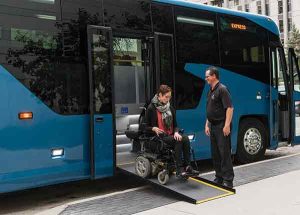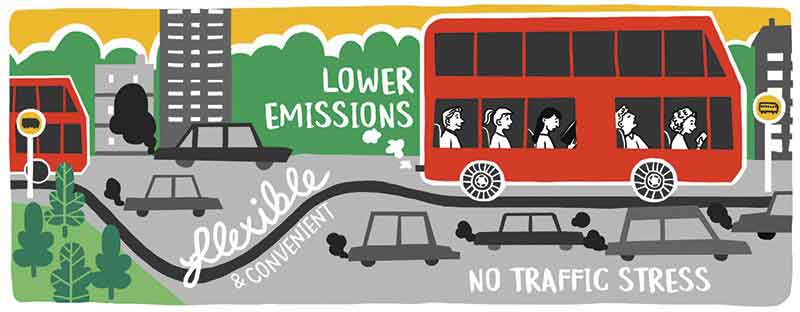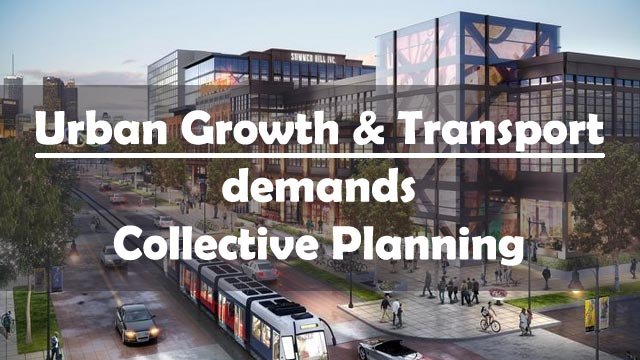
Benefits of Public Transportation in Today’s World
Public transportation in today’s world is on its move. Everywhere in the world, government organizations as well as people are discovering the benefits of traveling in buses, trains, metros, trams, pool-cabs and ferries etc. The benefits and importance of public transportation impact everyone, even those who may never board a train, metro or bus.
In a summarised way, below given are the key benefits of public transportation for developing moreover already developed cities in the world.
- Public transport plays a vital role in minimising the cost of congestion and maximising the economic productivity;
- Equality of access to employment and services, increased cohesion and decreased isolation are significant social benefits of public transportation; and
- By providing an alternative means of travel to private vehicles, public transport has a critical role to play in reducing carbon emissions globally.

Public transportation in the city of Portland in Oregon State of USA
Well recognition of all such benefits across various policy areas will form a basis for coordinated expansion of investments in public transportation by government agencies and assigned authorities for any country or any city in the world.
The city of Portland in Oregon State of USA is a perfect example of integrated public transportation system. People don’t need a car to live in the city as one can reach any part of the city by bus, train, streetcar, or bicycle.
1. Public Transportation: Diverse, Progressive and Expansive
If transport is understood to be a facilitator of the economy, public transport is critical in maximising productivity and competitiveness. Public transportation offers a variety of modes of travel, such as:
- Road vehicles: BRT, City bus, trolleybus, pool vans, paratransit service etc;
- Rail and other fixed guideways: heavy rail, light rail, commuter rail, automated guideway transit, cable car, monorail, tramway etc; and
- Waterways: passenger-only and vehicle ferries, water taxis etc.
Through the development smart technologies, today’s riders are finding that public transportation is very different, interesting and most importantly very affordable. Now a days Buses and trains are easy to get off and on with destination stops announced to riders. New information system with smart technologies alerts passengers by e-mail or cell phone alert when the next bus or train is coming. People plan their trips in advance on transit agency websites. Now so many commuter buses and trains have wifi capabilities; emerging as rolling Internet cafes to utilise time for work or online recreation.
Public transportation helps everyone; commuters, workers, families, students, senior citizens, persons with disabilities, as they seek to fulfil their personal and career goals, meet their daily needs and maintain a high level of independence in transportation. It is important to encourage commuters to come out of their private vehicles and ride on to attractive, user-friendly, integrated and expansive public transport networks.
2. Economic Benefits
Transportation is the backbone of a wealthy, strong and thriving economy, and proper investments in public transportation generate remarkable economic benefits. Public transportation not only helps to maintain and create employment, it also helps people to travel between the workplace and home. Jobs located close to public transportation, experience more employee reliability. Employers have a larger labour pool from which to choose, and employees are happier because they are not driving in congestion delays.

People residing in suburban areas who ride public transportation, are often move towards cities for work. Due to increased rider demand in cities, transit lines are extending to outlying suburban communities, and bus shuttles carry workers from rail lines to employer destinations in big areas like Delhi-NCR. For service and entry-level (fresher) employees with limited mobility options, transit is a key link to suburban-based jobs.
3. Social Benefits
Transport is a key factor in social inclusion. It helps to increase the ability of an individual, family or community to access economic and employment opportunities. It helps in education, healthcare and other services; and leisure, sporting and social activities. Public transport in major metropolitan cities can be the only, fastest, safest, and cheapest way to connect to work, family, and social activities; facilitating social inclusion and providing additional opportunity.

Less income earners, the unemployed, the elderly and differently abled people are particularly at risk of social isolation as a result of poor transport options. By providing improved access to public transport for these special groups is necessary to achieve social equality, as it invariably increases access to employment, education, health facilities and community services. Contrarily, limiting this access and the impost of expenses relating to vehicle ownership aggravate the social disadvantage experienced, especially by these groups.
Proper and integrated access to efficient public transport systems facilitates interaction between communities and individuals, contributing to maintain the overall fabric of society. From such perspective, public transport may be seen as a vital social institution which, if maintained properly and developed correctly, can benefit communities through magnified social cohesion.
4. Environmental Benefits
By removing private cars from our streets, public transport dramatically reduces air pollution from motor vehicles. As well as the obvious health benefits, reducing air pollution is also important to preserving natural environment. A cleaner environment not only improves the living standards in any city, but has significant long term flow on benefits to the economy.
Unlike private cars, the emissions from electrified modes such as metro rail and light rail are removed from the local environments in which they operate. As more renewable energy sources become available, there is potential for these modes to become completely sustainable in the coming future.

(Image Source : https://sustainability.leeds.ac.uk)
In general public transportation produces 95 percent less carbon monoxide (CO), and about half as much carbon dioxide (CO2) and nitrogen oxide (NOx), per passenger mile, compare to privately owned vehicles.
As national and international leaders look to tackle the challenges posed by climate change, the capacity of public transport to contribute to emissions reduction targets should be seriously considered. During peak time (generally office timings in weekdays), public transport emits six times less emission intensive per passenger kilometre than privately owned vehicles.
Conclusion
Public transportation is very critical to any nation’s future. To build a stronger economy; to conserve natural energy and resources; to reduce congestion; to fight with global warming; to provide improved air quality and health; to provide critical support during emergencies and disasters; to play with real estate values and development; to provide mobility for suburban and rural communities; to increase access for groups of all ages and circumstances; and to provide a better quality of life to citizens; provision of efficient public transportation is a must in any developed as well as developing cities.
It is important that everyone (individual commuters) must be aware of the key economic, social and environmental impact in the cities by their choice of public transportation. An enhanced awareness will definitely help skew travel behaviour of commuters towards more sustainable and low impact modes. Similarly, various governments, transportation communities and the private sector need to adopt bottom-down kind of approach for every public transport project appraisal; to better evaluate the actual impact by such huge investments in public transportation.
(Note: Images taken from Google image gallery)




